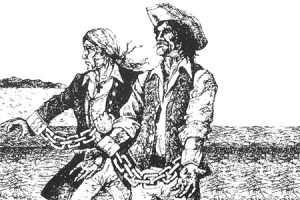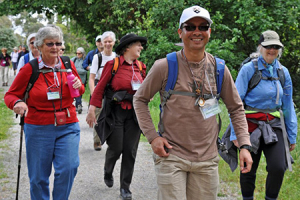St Teresa of Ávila - Special Centenary Events
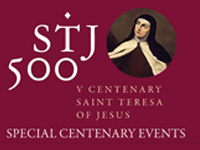 The Carmelite Centre Melbourne has released the program of events celebrating the 5th Centenary of the birth of St Teresa of Jesus.
The Carmelite Centre Melbourne has released the program of events celebrating the 5th Centenary of the birth of St Teresa of Jesus.
We are especially pleased to welcome Professor Bernard McGinn, renowned author, theologian and scholar of mysticism, who will give a public lecture and a workshop in Melbourne on 29 April and 1 May.
Other events include a Symposium on St Teresa, a retreat, and a talk by Professor Anne Hunt from Australian Catholic University.
Roque and Carlito Ordained Priests
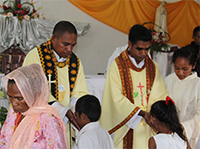 Fr Roque Soares Da Cruz and Fr Carlito Da Silva were ordained priests in Immaculate Conception Cathedral, Dili, on Friday 30 January this year.
Fr Roque Soares Da Cruz and Fr Carlito Da Silva were ordained priests in Immaculate Conception Cathedral, Dili, on Friday 30 January this year.
Fr Denis Andrew (Prior Provincial of Australia Timor Leste), Fr Bruce Clark (Regional Prior) and Fr Wayne Stanhope (Director of Formation) concelebrated the Ordination Mass together with East Timorese Carmelite, Religious and Diocesan Priests.
Carmelites celebrate Year of Consecrated Life
 In 2013 Pope Francis declared that a Year of Consecrated Life (YCL) be celebrated throughout the world. Pope Francis has dedicated this year to the promotion of consecrated life and asked the Church's religious sisters, brothers and priests to "wake up the world" with their testimony of faith and joy.
In 2013 Pope Francis declared that a Year of Consecrated Life (YCL) be celebrated throughout the world. Pope Francis has dedicated this year to the promotion of consecrated life and asked the Church's religious sisters, brothers and priests to "wake up the world" with their testimony of faith and joy.
The Communications Centre for the whole Carmelite Order has released a video to mark the occasion.
JPIC Newsletter February 2015
 In this issue:
In this issue:
- Power & Leadership in the Church and in the World
- The Prophet Elijah & the misuse of Power
- JPIC Calendar for February
- Prayers & Reflections
Roque & Carlito to be Ordained Priests
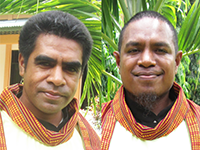 Our Deacons, Roque Soares da Cruz and Carlito da Silva, will be ordained priests on Friday 30 January in Immaculate Conception Cathedral, Dili, Timor Leste.
Our Deacons, Roque Soares da Cruz and Carlito da Silva, will be ordained priests on Friday 30 January in Immaculate Conception Cathedral, Dili, Timor Leste.
Bishop Norberto do Amaral, Bishop of Maliana Diocese, will preside at the Ordination due to the illness of the Bishop of Dili, Bishop Alberto Ricardo da Silva.
Carmelite YouTube channel launched
 Carmelite Communications now has its own YouTube channel.
Carmelite Communications now has its own YouTube channel.
The new YouTube channel provides a place for videos about Carmelite news, events and spirituality. Snapshots from various presentations at The Carmelite Centre Melbourne will also be added as they become available.
The channel currently has two videos about the 2014 Carmelite Way Pilgrimage and a day in the life of the Carmelites in Formation at Hera, Timor Leste.
Our New Zimbabwean Connection
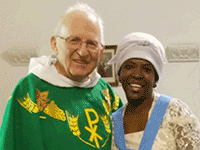 In 1956 three Carmelites from Australia, Fr William Morganti, Fr Robert Dowd and Br George Parsons travelled to Rhodesia (now called Zimbabwe) to work with the Irish Carmelites in their mission for the next 7 years.
In 1956 three Carmelites from Australia, Fr William Morganti, Fr Robert Dowd and Br George Parsons travelled to Rhodesia (now called Zimbabwe) to work with the Irish Carmelites in their mission for the next 7 years.
Our Zimbabwean connection has recently been renewed when Fr Jim Des Lauriers was asked to be Chaplain to the Zimbabwean community in Victoria.
A Day at Hera
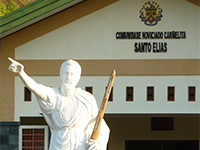
Thanks to our young Carmelites in Hera, Fiona Matthews (Whitefriars College) and Sue Stuckey you can get a glimpse of life in the Carmelite community at Hera in a new video.
Sue also visited Timor Leste recently helping our students continue their study of English.
East Timor Mission Partners
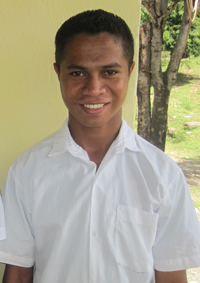 Sabino, 20, is in Year 12 at high school in Zumalai. He lives in the Carmelite boarding house – here he has a place to live and study, food to eat, school books and uniform. Sabino wants to study English and computer skills when he finishes high school.
Sabino, 20, is in Year 12 at high school in Zumalai. He lives in the Carmelite boarding house – here he has a place to live and study, food to eat, school books and uniform. Sabino wants to study English and computer skills when he finishes high school.
"The Carmelites teach us to pay attention to our studies and show us we need to be grateful for this experience by praying to God and sharing in daily prayer with the Carmelites' he says. He doesn't want to fail.
Sabino is very aware that as the oldest male in his family (his father died in 2009) he must study hard so he can get a good job to look after his mother, 10 brothers and sisters.
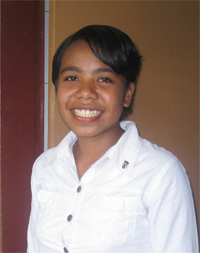 Then there's Gloria, who showed courage and initiative in asking The Carmelites for help.
Then there's Gloria, who showed courage and initiative in asking The Carmelites for help.
Gloria, 19, comes from Zumalai and after completing a 12 month course in English received a scholarship from The Carmelites so she can study in Dili University. Gloria dreams of becoming a teacher, teaching English in the parish primary school and to youth in Zumalai.
An education will enable Gloria to be employed and earn an income to support her family. At the same time, Gloria will make a valuable contribution to her students and other young people by helping them learn English which will increase their chances of future employment.
As Sr Rosemary says, "It's amazing to see the transformation of these young people - to see them striving to become something, to change the circumstances of their families, their communities and their own selves."
Our Mission Partners provide courage, hope and dreams for the next generation.
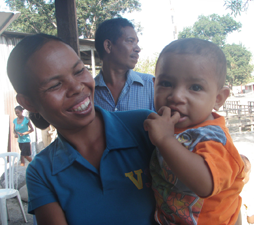 Lucinda is too ill to look after Louis, her 18 month old son. She has asked the Carmelites to find a family who will care for him. She hopes her son never experiences poverty. In order to grow up well, Louis will need lots of love, nutritious food, safe drinking water, vaccines to help build up his immune system and an education so he can eventually find work. For the next 18 years Louis will depend on caring people like you to help him grow up and break free from poverty.
Lucinda is too ill to look after Louis, her 18 month old son. She has asked the Carmelites to find a family who will care for him. She hopes her son never experiences poverty. In order to grow up well, Louis will need lots of love, nutritious food, safe drinking water, vaccines to help build up his immune system and an education so he can eventually find work. For the next 18 years Louis will depend on caring people like you to help him grow up and break free from poverty.
It's a big commitment we are making to Louis, Gloria and Sabino. Without the inspiration of St Therese we wouldn't have the courage to ask. Without the courage of St Therese we wouldn't have the confidence to believe that together we can help them.
Over 30 caring Mission Partners believe in our mission in East Timor. They help us, through monthly gifts, to provide the practical means to transform lives and rebuild hope.
Why not join them?
Contact us for more information: (03) 9690 8822 or This email address is being protected from spambots. You need JavaScript enabled to view it.
Carmelites
Carmelites work with communities in Australia and Timor-Leste (East Timor) helping people to transform their lives.
Community speaks of trust and relationships with one another, and the Carmelites' commitment to strengthen and support all those who are part of our family within Australia and Timor-Leste.
Prayer speaks to the heart of what is Carmelite: our relationship with God. Through liturgy and prayer Carmelites are committed to supporting and sustaining you on your spiritual journey.
Service speaks to the Carmelite attitude of responding positively to the needs of the people we serve; empowering and accompanying them in their experiences and in their faith.
WHO ARE WE
Carmelites have a tradition spanning eight centuries originating in the 1190's in the Holy Land with the first Carmelites arriving in Australia in 1802.
Since arriving in Australia The Carmelites have been actively involved with Australian communities through parish ministry, schools, spirituality and retreat centres, and library offering pastoral and spiritual companionship to people.
Since 2001 The Carmelites have been supporting the people of Timor-Leste both spiritually and through assisting in the reconstruction of their communities. Through the friendships that have been established we aim to empower the Timorese people to rebuild their own communities and help them recover from the hurt of their painful past.
THE CARMELITES IN TIMOR-LESTE
Timor-Leste is the poorest country in the Asia Pacific region and a very close neighbour to Australia. The Timorese people have lived through traumatic experiences and our help is needed to assist them on the journey from despair to living richer fuller lives.
Our mission in Timor-Leste is to:
- Educate young men to become Carmelites and work within their communities
- Educate students, through offering scholarships and traineeships
- Train young people in skills to gain employment in industries
- Refurbish essential buildings eg; schools, youth centres
- Provide training and equipment to assist in agricultural programs
- Provide safe drinking water
- Offer Sacramental Programs for communities
- Provide pastoral and spiritual companionship for life's journey
You can help with our mission by becoming involved and helping us to give others the opportunity for a better life.
THE CARMELITES IN AUSTRALIA
In Australia Carmelites work in a variety of areas serving communities and offering their prayer and companionship
Our Ministries involve
- Running a Catholic College for boys
- Administering parishes around Australia
- Supporting lay men and women to live a reflective life
- Providing pastoral support to those suffering in our communities
- Working as chaplains in hospitals and schools to support people at their most vulnerable
- Providing a theological resource in The Carmelite Library for academics and those seeking a deeper meaning in life
- Offering courses through The Carmelite Centre which supports people in their life journey
- Spirituality and retreat centre for spiritual healing which offer a place for reflection and pastoral care
- Offering a reflective place at The National Shrine of Our Lady of Mount Carmel where people can share together through companionship and prayer
HOW THE CARMELITES CAN SUPPORT YOU
At times each one of us is challenged by the pain and hurt that our life journey brings. It is at times like this that The Carmelites offer companionship, hope and a place to share faith which can help give great strength during these difficult times.
The Carmelites offer their prayer and companionship through five special Masses celebrated throughout the year at The National Shrine of Our Lady of Mount Carmel. Each of these Masses provide opportunities for people to come together in prayer to give thanks, to pray for healing and to remember loved ones.
Carmelite Mass Celebrations
- Mothers– for all mothers living and deceased (July)
- Remembrance – for deceased relatives and friends (November)
- Christmas – for all your needs and intentions (December)
Each of these masses is open to all either by attendance or by responding with personal intentions.
Carmelite Prayer Cards
When family and friends become ill, lose their job, have a relationship break-down or suddenly find themselves alone, it is comforting to know that they have the support of their family, friends and – people like The Carmelites.
The Carmelites provide beautiful reflective prayer cards which can be sent on these occasions to assure those you care for of The Carmelites' prayers and your love and support for them. Because these cards are exclusive to The Carmelites each person who receives one will receive a beautiful unique gift and card.
We have prayer cards for
- Healing and Peace for those who are sick
- A gift of Prayer for any occasion
- Spiritual support for those going through physical or emotional struggles
- Sympathy and Mass for those recently deceased
- Special Occasion for birthdays, anniversaries and special days
pdf Carmelite Prayer Card Order Form
GET INVOLVED
The Carmelites undertake many activities which support and serve the community both in Australia and East Timor. We invite you to become involved and help us to raise awareness and funds to support these services.
Become a member of The Carmelites and receive
- Our newsletter ‘Carmel Contact' FREE
which features articles of reflection and meditation as well as updates on the life and work of The Carmelites in Australia and East Timor .
- Invitations to participate in the Masses at The National Shrine of Our Lady of Mount Carmel
- Mass cards to forward to family and friends
- Invitations to attend special gatherings and major events
Purchase goods which help us raise money for Timor-Leste
- Timorese organic coffee
- Tias [traditional woven cloth]
- Recycle bags
- Occasional cards
- Christmas cards
If you would like to join us, purchase goods or find out more, please contact:
This email address is being protected from spambots. You need JavaScript enabled to view it.
Carmelite Province Centre
75 Wright Street
Middle Park Vic 3206
Telephone: 03 9690 8822
Lay Carmelites in Botany Bay
Although the first official Carmelites foundation in this country was made in 1881, the first Carmelites in Australia had arrived nearly eighty years before. They were the Lay Carmelites (Tertiaries or Confraternity members) James Dempsey and John Butler. Both were transported to Botany Bay for life for their alleged involvement in the Irish Rebellion of 1798.
Carmelite Figures
There are many famous Carmelites who have influenced generations of spiritual seekers throughout the Order's history. Here are just some of them.
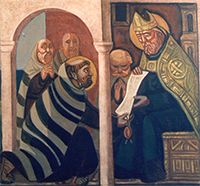 Saint Albert of Jerusalem was born in Emilia, Italy in the mid 12th Century. He became a Canon Regular of the Holy Cross at Mortara (Pavia) where he was elected Prior in 1180. He was appointed Bishop of Bobbio in 1184 and of Vercelli the following year. During his 20 years there he undertook a number of missions of national and international importance. He brokered peace between the cities of Pavia and Milan in 1194 and between the cities of Parma and Piacenza in 1199. In 1191 he held a Diocesan Synod, the statutes and decrees of which continued to serve as a norm until modern times.
Saint Albert of Jerusalem was born in Emilia, Italy in the mid 12th Century. He became a Canon Regular of the Holy Cross at Mortara (Pavia) where he was elected Prior in 1180. He was appointed Bishop of Bobbio in 1184 and of Vercelli the following year. During his 20 years there he undertook a number of missions of national and international importance. He brokered peace between the cities of Pavia and Milan in 1194 and between the cities of Parma and Piacenza in 1199. In 1191 he held a Diocesan Synod, the statutes and decrees of which continued to serve as a norm until modern times.
In 1205 he was elected Patriarch of Jerusalem and soon after nominated as papal legate for the ecclesiastical province of Jerusalem. He arrived in Palestine early in 1206, taking up residence at Acre, at the foot of Mount Carmel, as Jerusalem was occupied by the Saracens. In Palestine he continued his peace-making efforts not only between Christians but also between them and non-Christians.
On 14 September 1214 he was stabbed to death during a procession to celebrate the Feast of the Exaltation of the Cross by the Master of the Hospital of the Holy Spirit whom Albert had denounced for his unjust and abusive behaviour.
Somewhere between his arrival in Palestine in 1206 and his death in 1214 the first group of Carmelites asked Albert to write for them a "formula of life" which later became the Carmelite Rule approved by Pope Innocent VI in 1247.
 Saint Teresa of Avila, who almost single handedly reformed the order in the 16th century, was responsible for the establishment of the Discalced Carmelites in the latter part of the century. Her life was a colourful and supernatural series of events that had amazed and awed observers and followers of the order for centuries. Teresa was born in Avila in Spain in 1515. She entered the Carmelites and made great progress in the way of perfection and was granted mystical revelations. Wishing to share in the spiritual renewal of the Church of her time, she began to live her religious life more ardently and soon attracted many companions, to whom she was like a mother. She also helped in the reform of the friars with Saint John of the Cross, and in this had to endure great trials. She wrote books which are renowned for their depth of doctrine and which showed her own spiritual experiences. She died at Alba de Tormes in 1582. In 1970 Teresa was declared a Doctor of the Church by Pope Paul VI.
Saint Teresa of Avila, who almost single handedly reformed the order in the 16th century, was responsible for the establishment of the Discalced Carmelites in the latter part of the century. Her life was a colourful and supernatural series of events that had amazed and awed observers and followers of the order for centuries. Teresa was born in Avila in Spain in 1515. She entered the Carmelites and made great progress in the way of perfection and was granted mystical revelations. Wishing to share in the spiritual renewal of the Church of her time, she began to live her religious life more ardently and soon attracted many companions, to whom she was like a mother. She also helped in the reform of the friars with Saint John of the Cross, and in this had to endure great trials. She wrote books which are renowned for their depth of doctrine and which showed her own spiritual experiences. She died at Alba de Tormes in 1582. In 1970 Teresa was declared a Doctor of the Church by Pope Paul VI.
 Saint John of the Cross was born at Fontiveros in Spain about 1542. He entered the Carmelites and with the permission of his superiors began to live a stricter life. Later he was persuaded by St Teresa to begin, together with some others, a reform within the Carmelite friars which cost him much hard work and many trials. He died in Ubeda in 1591, outstanding in holiness and wisdom, to which his many spiritual writings give eloquent witness. His writings were first published in 1618. After his death the reform he introduced within the friars eventually separated from the Carmelite Order to become the Order of Discalced Carmelite Friars. John was canonised in 1726 and declared a Doctor of the Church in 1926.
Saint John of the Cross was born at Fontiveros in Spain about 1542. He entered the Carmelites and with the permission of his superiors began to live a stricter life. Later he was persuaded by St Teresa to begin, together with some others, a reform within the Carmelite friars which cost him much hard work and many trials. He died in Ubeda in 1591, outstanding in holiness and wisdom, to which his many spiritual writings give eloquent witness. His writings were first published in 1618. After his death the reform he introduced within the friars eventually separated from the Carmelite Order to become the Order of Discalced Carmelite Friars. John was canonised in 1726 and declared a Doctor of the Church in 1926.
Famous Carmelites of the 20th Century include
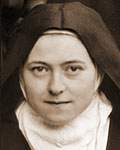 Saint Therese of Lisieux, one of only four women Doctors of the Church, so named because of her famous teaching on the 'way of confidence and love' set forth in her best-selling memoir, 'Story of a Soul'. Thérèse Martin was born in Alencon in France in 1873. Whilst still young she entered the Discalced Carmel of Lisieux, where she lived - as Sister Thérèse of the Child Jesus and the Holy Face - in the greatest humility and evangelical simplicity and confidence in God. By word and example she taught the novices these same virtues.
Saint Therese of Lisieux, one of only four women Doctors of the Church, so named because of her famous teaching on the 'way of confidence and love' set forth in her best-selling memoir, 'Story of a Soul'. Thérèse Martin was born in Alencon in France in 1873. Whilst still young she entered the Discalced Carmel of Lisieux, where she lived - as Sister Thérèse of the Child Jesus and the Holy Face - in the greatest humility and evangelical simplicity and confidence in God. By word and example she taught the novices these same virtues.
Offering her life for the salvation of souls and the spread of the Church, she died on 30 September 1897. She was 24 years old. She was declared a Doctor of the Church in 1997.
 Blessed Titus Brandsma, a Dutch scholar and writer who was killed in Dachau Concentration Camp because of his stance against Nazism. Born at Bolsward (The Netherlands) in 1881, Titus joined the Carmelite Order as a young man. Ordained priest in 1905, he obtained a doctorate in philosophy in Rome. He then taught in various schools in Holland and was named professor of philosophy and of the history of mysticism in the Catholic University of Nijmegen where he also served as Rector. He was noted for his constant availability to everyone and for his concern for his students for whom he collected food, clothing and blankets.
Blessed Titus Brandsma, a Dutch scholar and writer who was killed in Dachau Concentration Camp because of his stance against Nazism. Born at Bolsward (The Netherlands) in 1881, Titus joined the Carmelite Order as a young man. Ordained priest in 1905, he obtained a doctorate in philosophy in Rome. He then taught in various schools in Holland and was named professor of philosophy and of the history of mysticism in the Catholic University of Nijmegen where he also served as Rector. He was noted for his constant availability to everyone and for his concern for his students for whom he collected food, clothing and blankets.
He was a professional journalist, and in 1935 he was appointed ecclesiastical advisor to Catholic journalists. Both before and during the Nazi occupation of The Netherlands he fought, faithful to the Gospel, against the spread of the Nazi ideology and for the freedom of Catholic Education and the Catholic Press. For this he was arrested and sent to a succession of prisons and concentration camps where he brought comfort and peace to his fellow prisoners and did good even to his tormentors. In 1942, after much suffering and many humiliations, he was killed by lethal injection at Dachau. He was beatified by John Paul II on 3 November 1985.
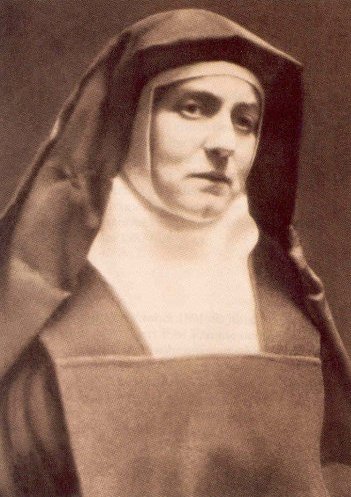 Saint Teresa Benedicta of the Cross, a Jewish convert to Catholicism who was also imprisoned and died at Auschwitz. Edith Stein was born to a Jewish family at Breslau on 12 October 1891. Through her passionate study of philosophy she searched after truth and found it in reading the autobiography of St Teresa of Jesus (Avila). In 1922 she was baptised and in 1933 she entered the Carmel of Cologne where she took the name Teresa Benedicta of the Cross. She was gassed and cremated at Auschwitz on 9 August 1942 during the Nazi persecution and died a martyr for the Christian faith after having offered her holocaust for the people of Israel. A woman of singular intelligence and learning, she left behind a body of writing notible for its doctrinal richness and profound spirituality. She was beatified by Pope John Paul II at Cologne on 1st May 1987, and canonised by him in 1998. In 1999 she was declared one of the six patron saints of Europe.
Saint Teresa Benedicta of the Cross, a Jewish convert to Catholicism who was also imprisoned and died at Auschwitz. Edith Stein was born to a Jewish family at Breslau on 12 October 1891. Through her passionate study of philosophy she searched after truth and found it in reading the autobiography of St Teresa of Jesus (Avila). In 1922 she was baptised and in 1933 she entered the Carmel of Cologne where she took the name Teresa Benedicta of the Cross. She was gassed and cremated at Auschwitz on 9 August 1942 during the Nazi persecution and died a martyr for the Christian faith after having offered her holocaust for the people of Israel. A woman of singular intelligence and learning, she left behind a body of writing notible for its doctrinal richness and profound spirituality. She was beatified by Pope John Paul II at Cologne on 1st May 1987, and canonised by him in 1998. In 1999 she was declared one of the six patron saints of Europe.
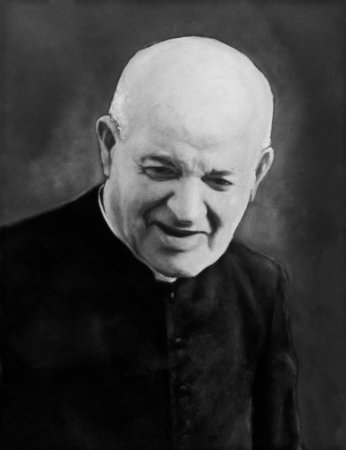 Saint George Preca was born in Valletta, Malta, on 12 February 1880. Ordained priest in 1906, he immediately began working with young people. In 1907 he founded the Society of Christian Doctrine, commonly known as M.U.S.E.U.M. (Magister Unitam Sequatur Evangelium Universus Mundus). He dedicated his life to preaching and teaching. His effective ministry was the fruit of a life of prayer and constant meditation on the Sacred Scriptures. On 21st July 1918, Fr George was received into the Carmelite Third Order and one year later, on 26th July 1919, he made his profession. In 1952 he was 'affiliated' to the Order as a recognition of his efforts to spread devotion to the Blessed Virgin Mary under the title of Our Lady of Mount Carmel. He died on 2nd July 1961 and was beatified by Pope John Paul II on 9 May 2001, and canonised by Pope Benedict XVI on 3 June 2007. His canonisation made Saint George the first member of the Carmelite Third Order to be formally recognised by the Church as a saint.
Saint George Preca was born in Valletta, Malta, on 12 February 1880. Ordained priest in 1906, he immediately began working with young people. In 1907 he founded the Society of Christian Doctrine, commonly known as M.U.S.E.U.M. (Magister Unitam Sequatur Evangelium Universus Mundus). He dedicated his life to preaching and teaching. His effective ministry was the fruit of a life of prayer and constant meditation on the Sacred Scriptures. On 21st July 1918, Fr George was received into the Carmelite Third Order and one year later, on 26th July 1919, he made his profession. In 1952 he was 'affiliated' to the Order as a recognition of his efforts to spread devotion to the Blessed Virgin Mary under the title of Our Lady of Mount Carmel. He died on 2nd July 1961 and was beatified by Pope John Paul II on 9 May 2001, and canonised by Pope Benedict XVI on 3 June 2007. His canonisation made Saint George the first member of the Carmelite Third Order to be formally recognised by the Church as a saint.
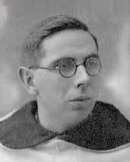 Blessed Hilary Januszewski was a Polish Carmelite born on 11 June 1907 and joined the Carmelites in September 1927. Following his studies and ordination in Rome he was appointed lecturer in Dogmatic Theology and in Church History for the students of the Polish province in Krakow. In 1939 he was appointed Prior of that community. World War II was to jeopardise all the hopes and projects of the young prior. On 1 September 1939, after several months of widespread international tension, Germany declared war on Poland. Twenty days later, Soviet troops launched an attack from the East. A year after the invasion, the invading forces ordered the arrest of large numbers of monks and priests. On 18 September five Carmelites were arrested including Fr Hilary, who offered to go instead of Fr Konoba, who was older than him and sick. In the concentration camp at Dachau he volunteered to look after prisoners suffering from typhus in the infamous Hut 25. After 21 days serving the sick, he died of typhus. Read the full story of Fr Hilary.
Blessed Hilary Januszewski was a Polish Carmelite born on 11 June 1907 and joined the Carmelites in September 1927. Following his studies and ordination in Rome he was appointed lecturer in Dogmatic Theology and in Church History for the students of the Polish province in Krakow. In 1939 he was appointed Prior of that community. World War II was to jeopardise all the hopes and projects of the young prior. On 1 September 1939, after several months of widespread international tension, Germany declared war on Poland. Twenty days later, Soviet troops launched an attack from the East. A year after the invasion, the invading forces ordered the arrest of large numbers of monks and priests. On 18 September five Carmelites were arrested including Fr Hilary, who offered to go instead of Fr Konoba, who was older than him and sick. In the concentration camp at Dachau he volunteered to look after prisoners suffering from typhus in the infamous Hut 25. After 21 days serving the sick, he died of typhus. Read the full story of Fr Hilary.
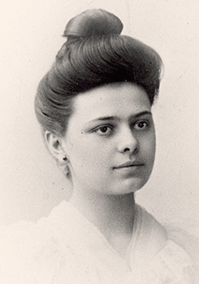 St Elizabeth of the Trinity was born on 18 July 1880. As a young child she earned a reputation as an incessant chatterbox and vivacious crawler. She was strong-willed and determined. As she grew up she became known for her generous and loveable nature. She was an excellent musician whose concerts won critical acclaim. At the same time her awareness of God began to grow. In the midst of a busy social life she managed to find time to help with troubled youth and seemed to radiate the presence of God wherever she went. She entered the Carmelite Convent at Dijon in 1901. She was given the name 'Elizabeth of the Trinity'. Here she grew in the Carmelite attributes of reflective prayer, living in the present moment, loving God wholeheartedly and serving others with simplicity. Much like St Therese of Lisieux, Elizabeth's way was one of simple conversation with God and a deep, abiding awareness of God's presence within. Read the full story of St Elizabeth of the Trinity.
St Elizabeth of the Trinity was born on 18 July 1880. As a young child she earned a reputation as an incessant chatterbox and vivacious crawler. She was strong-willed and determined. As she grew up she became known for her generous and loveable nature. She was an excellent musician whose concerts won critical acclaim. At the same time her awareness of God began to grow. In the midst of a busy social life she managed to find time to help with troubled youth and seemed to radiate the presence of God wherever she went. She entered the Carmelite Convent at Dijon in 1901. She was given the name 'Elizabeth of the Trinity'. Here she grew in the Carmelite attributes of reflective prayer, living in the present moment, loving God wholeheartedly and serving others with simplicity. Much like St Therese of Lisieux, Elizabeth's way was one of simple conversation with God and a deep, abiding awareness of God's presence within. Read the full story of St Elizabeth of the Trinity.
Fr Hilary Januszewski
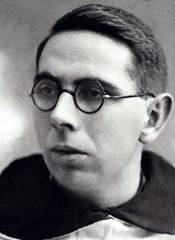 "Faithful in little, faithful in much…."
"Faithful in little, faithful in much…."
A letter by Fr Joseph Chalmers Prior General of the Carmelites on the occasion of beatification of Fr Hilary Januszewski, O.Carm.
13 June 1999
Dear brothers and sisters in Carmel,
The Holy Father, Pope John Paul II, during his next apostolic visit to Poland, will beatify 108 martyrs who were victims of the nazi persecution during World War II. Among them is our brother, Father Hilary Januszewski.
Dachau and the Carmelites
Along with some magnificent human, scientific, social and political achievements, the twentieth century, now drawing to a close, will leave us with a number of dreadful names: Auschwitz, Hiroshima, Verdun, Rwanda and others, each an example of the horror, barbarity and disregard for humankind which has also marked this century. Dachau is one of those names. It was the first concentration camp opened by the national-socialism, back in March 1933, on the premises of a former arms factory. It was also practically the last one to be freed, on 29 April 1945. The name of this noble barbarian town, near Munich, famous for its nineteenth-century school of painting and the hospitality of its people, became forever linked to the Lager (concentration camp).
On 16 July 1942 an unusual clandestine ceremony was held to celebrate the feast of Our Lady of Mount Carmel. Several Carmelites, from different parts, were imprisoned at the camp at the same time in the huts reserved for the clergy. That morning, at dawn, before setting out for their forced labour, they joined hands to celebrate with joy, despite the appalling nature of the circumstances, the fact that even there they could be and persevere sub tutela matris.
One of them was Father Titus Brandsma, a Dutch Carmelite, journalist and lecturer at the University of Nimega (of which he was Rector Magnificus), imprisoned for defending the rights of the Catholic press against the forces of domination and for trying to save a group of Jewish children. He was beatified by John Paul II in November 1985. One of his companions was Brother Raphael Tijhuis, who was with him during the last days of his life and who was the main witness of these dramatic events.[1]
Father Albert Urbanski was also there. He was a Polish Carmelite who was to write some beautiful letters to the Curia General in Rome shortly after the camp was liberated in May 1945, describing his experiences over the years in which he was deprived of his freedom and the most basic rights. He set an example by putting himself at the service of the Order right from the beginning.[2] Urbanski wrote one of the first accounts of the camp and the priests’ life there.[3] After the War, he did some marvellous work in several positions of responsibility. He was provincial from 1964 to 1967. He was the first president of the Studium Josephologiae Calissiae (under the Polish Studium Mariologiae).[4]
Several other Polish Carmelites were imprisoned at the camp. Some of them survived the hell of Dachau, although they came out of it severely marked by the experience, both physically and psychologically. Others, however, lost their lives there. Among them we find Father Leon Michail Koza, who died on the vigil of Ascension Day in 1942 through exhaustion owing to the tough labour in the fields;[5] Father Szymon Buszta, who died a few weeks after Father Koza, also as a result of physical and psychological exhaustion [6] and Father Bruno Makowski.[7] Together with them, we should mention G. Kowalski, who died in Auschwitz in November 1940, while waiting to be transferred to Dachau [8].
Father Hilary Januszewski, the one who will soon be beatified by Pope John Paul II, was also there. He is the second Carmelite of this century to be beatified, which is a source of deep satisfaction for the whole Carmelite family.
Father Hilary Januszewski
Father Januszewski was born in Krajenki on 11 June 1907. He was christened Pawel and educated in the Christian faith by his parents, Martin and Marianne. After going to school in Greblin (where the family lived from 1915), he continued his studies at the secondary school (Gimnasium) in Suchary, which he had to leave later because of financial difficulties in the family. After periods at other schools, he went to Krakow, where he did a number of courses (including correspondence courses) and joined the Order of the Our Lady of Mount Carmel in September 1927, whereupon he changed his name to Hilary. After his noviciate, he took his vows on 30 December 1928 and moved to Krakow to do his studies for the priesthood. After these studies he was sent to Rome to study at St. Albert’s International College. There he lived with Carmelites from all over the world who were concerned with how the situation in Europe was becoming increasingly complicated and how tension was rising all the time. The young Hilary proved to be a silent and prudent man, who loved studying. People could sense in him a deep inner life and a wealth of spiritual experience, as some of his colleagues, including Prior General, Father Kilian Healy [9], were to indicate later on. He was ordained on 15 July 1934. In Rome, he came into contact with a generation of Carmelites who were to mark the history of the Order during this century: Xiberta, Brenninger, Esteve, Grammatico, Driessen and others.
Upon his return to Poland, he was appointed lecturer in Dogmatic Theology and in Church History for the students of the Polish province in Krakow. In 1939 he was appointed Prior of that community by the provincial, Father Eliseo Sánchez Paredes, one of the Spanish Carmelites who had been sent to Poland to help in the restoration of this province.
World War II was to jeopardise all the hopes and projects of the young prior. On September 1, 1939, after several months of widespread international tension, Germany declared war on Poland. It was the beginning of a terrible month in the recent history of Poland. Twenty days later, Soviet troops launched an attack from the East. A weak Polish army surrendered on both fronts at the end of that month. Poland was once again humiliated and divided. Mass deportations, destruction, annihilation of Jewish communities followed in quick succession. The Polish clergy did not escape this persecution. A year after the invasion, the invading forces ordered the arrest of large numbers of monks and priests. The Carmelites in Krakow were particularly hard hit: on September 18 A. Urbanski, A. Wszelaki, M. Nowakowski and P. Majcher were all arrested, to be followed shortly afterwards by the prior of the community H. Januszewski, who offered to go instead of P. Konoba, who was older than him and sick. Father Januszewski acted heroically without stopping to consider the consequences of his action, guided by his conscience and his Christian and religious values, by what he considered to be his obligation as the head of a Carmelite community. He was arrested and, after some time at the Montelupi prison in Krakow and several concentration camps, he ended up at Dachau.
During the severe winter of 1945, news began to filter through that the German army was growing weak and that there was a possibility of retreat and even of freedom. Life at the camp had become unbearable. In addition to the normal conditions, there were constant threats of bombings and reduced rations. The kapos (prisoners in charge of working parties) were continually on edge, intensifying beatings and other forms of repression.
Hut 25 was being used to group together, in the most inhumane conditions, all the prisoners with typhus fever, who were constantly growing in number. The camp authorities offered the Polish priests the opportunity to put their "theories" of Christian charity into practice and look after the typhus patients. Freedom was by then imminent and the risk of death in the wretched hut 25 was very high. However, the silent Carmelite was one of the first volunteers.
What he said to his friend Father Bernard Czaplinski (later the Bishop of Chelm) shortly before he set off for the hut leaves one very moved even today: You know I won’t come out of there alive….[10]
Sure enough, Father Januszewski never left Dachau alive. After 21 days serving the sick, he died of typhus. Hut 25 had become a coffin, which the Americans, who freed the Lager a few days later, found crammed with hundreds of corpses.
His testimony for us today
The beatification of Father Januszewski is a source of joy and happiness for all Carmelites. The Church has considered one of our brethren an intercessor and an example, a valid witness for the universal Church. This is an occasion for Carmelites not only to feel that joy and to celebrate it, but also to reflect upon and to think deeply about Father Januszewski’s testimony, to find in his example keys to our own way of living today.
First of all, there is a good example in the biography of Father Januszewski of a selfless, quiet, silent life, founded upon deep prayer and service of others. Those who knew him insist that he was remarkably simple. Had it not been for his heroic death, he would probably have been forgotten, because he never stood out in extraordinary things.[11] But with that strength that grows from a life of prayer, acting in the presence of the Lord - something very typical and genuine in Carmelite spirituality - he gave himself up for others with the same simplicity with which he lived a quiet, hard-working life. A person educated in daily devotion generously offered his life when faced with arrest and the reality of the concentration camp. We could say that he succeeded in being faithful to his vocation in ordinary circumstances and, as a result, was also able to be just as faithful in truly extraordinary circumstances. Faithful in very little, he was faithful also in much (Lk 16, 10).
Father A. Urbanski, with whom he was joined both in religious life and in fate, writing to the Carmelite Curia in Rome from the camp during the forced quarantine following liberation, interpreted his death as follows:
Proh dolor R.P. Hilarius Januszewski, die 26.3.45, uno Mense ante liberationem, tanquam victima zelus sacerdotalis erga infectuose infirmos, mortuus est.[12]
As this century draws to a close, we are horrified by certain events that have taken place during it. We find the experience of the concentration camps in which Father Januszewski lost his life especially cruel and inhuman. However, there are situations even now that are, in a way, very similar: racial hatred, poverty and starvation, wars of all kinds, massacres, intolerant violent nationalist movements… The testimony of Father Januszewski invites the Carmelites of the twenty-first century to make a radical option for life, which nowadays is threatened in so many ways. He was able to do this in the most sublime way, giving up his own life for that of others.[13]
Father Januszewski’s example reminds us that Carmelites are called to vouch for life in the midst of a "culture of death", which shows itself in many different ways, not only in those regions of the world in which that "culture of death" is more obvious, but also in other areas where its presence is more subtle. Moreover, in the face of the temptation of "usefulness", of valuing human beings for what they produce, and eliminating those who are no longer useful and become a burden, Father Januszewski opted radically for the dying, the useless, those who apparently had nothing left to offer. With this action, he proclaimed and testified to the sacred value of human life, for itself and in itself. This witness given by Hilary Januszewski went to the ultimate limit, the giving of his own life.
We also find in Father Januszewski an especially interesting example for our experience of the Carmelite charism today. Januszewski, a man of silence and prayer, accustomed to talking to God, devoted to contemplation -like any good Carmelite - had no difficulty in finding the face of Christ in the weak, the needy and the suffering. In the awful conditions of Dachau, those with typhus fever, the dying, were the poorest of the poor and Father Januszewski, along with other priest volunteers, was willing to stay with them and end up dying with them and for them.
A life of intense prayer makes us more human and more capable of living in solidarity with others; it gives us the necessary intuition and sensitivity to discover the mysterious presence of the Lord in those who are weakest, in the midst of the tensions and contradictions of life. Like John in the boat on the Lake of Galilee, between the darkness of the passing night and the light of dawn, the Carmelite is called to proclaim, humbly but firmly: It is the Lord (Jn 21, 7).
Finally, the witness of Hilary Januszewski, soon to be called blessed must show Carmelites throughout the world the meaning of the international dimension of our Order. We must not forget that most of the patients Father Januszewski looked after were Russians (that is, from an enemy country). But this, seemingly, did not affect his decision. Overcoming national barriers, Father Januszewski offers us a true witness to universal fraternity, to reconciliation between enemy nations, and to peace.
Three years earlier, Blessed Titus Brandsma had ended a document, requested of him as part of the investigation into the opposition of Dutch Catholics to national-socialism, with the following words: God save Holland! God save Germany! Let God make these two nations walk in peace and freedom once again and recognise his Glory!
May the example and intercession of these two blessed Carmelites help us to enter the twenty-first century with a real spirit of service, peace and justice born out of a true and intense encounter with our Risen Lord.
Rome, 19 March 1999
Solemnity of St. Joseph
Fr Joseph Chalmers, O.Carm.
Prior General
Footnotes
1 R. TIJHUIS, Met Pater Titus Brandsma in Dachau: Carmelrozen 31-32 (1945/46) 18-21, 53-58, 80-85. The English translation may be consulted in: Dachau Eye-witness, in: AA.VV., Essays on Titus Brandsma [R. Valabek, ed.] (Rome 1985) 58-67.
2 F. MILLAN ROMERAL, Carmelitas en Dachau: las cartas del P. A. Urbanski, desde el lager, en el 50 aniversario de la liberación: Carmelus 42 (1995) 22-43.
3 A. URBANSKI, Duchowni w Dachau (Krakow 1945).
4 Cf. JUAN BOSCO DE JESÚS, Dos figuras de la Josefología en Polonia recientemente desaparecidas: PP. Alberto Urbanski, O.Carm. (1911-1985) y Estanislao Ruminski (1929-1984): Estudios Josefinos 40 (1986) 91-98.
5 Cf. Necrología (Obituary): Analecta O.Carm. 11 (1940-1942) 219; A. URBANSKI, Duchowni w Dachau, 61-66.
6 Cf. Necrología (Obituary): Analecta O.Carm. 12 (1943-1945) 230; A. URBANSKI, Duchowni w Dachau, 65-66.
7 Cf. Necrología (Obituary): Analecta O.Carm. 12 (1943-1945) 230; A. URBANSKI, Duchowni w Dachau, 61-66.
8 His photographs may be seen in the splendid photograph album published recently by the Carmelite Province of Poland: R. RÓG, Duch, Historia, Kultura (Krakow 1997) 68-69.
9 K. HEALY, Prophet of Fire (Rome 1990) 181-184 (Italian and Spanish versions available)
10 In the same sense, see the testimony of: F. KORSZYNSKI, Un vescovo polacco a Dachau (Brescia 1963) 125. This is the Italian translation (with a preface by the then Cardenal Montini) of Jasne promienie w Dachau (Poznan 1957).
11 Cf. K. HEALY, Prophet of fire (Rome 1990) 181-184.
12 F. MILLAN ROMERAL, Carmelitas en Dachau: las cartas del P. A. Urbanski, desde el lager, en el 50 aniversario de la liberación: Carmelus 42 (1995) 37. In another letter, written in German, he insists on this: "Als Opfer zelus sacerdotalis ist er gestorben" (ibid. 42).
13 Cf. R. VALABEK, Greater Love Than This... Father Hilary Januszewski, O. Carm.: Carmel in the World 30 (1991) 209-216.
Carmel Contact
Carmel Contact is a newsletter of the Carmelites of Australia and Timor Leste
Carmelite Library
Carmelite’s National Treasure
It has been called “a national treasure” but for well over 100 years it has been accessible to just a few.
Now that has changed. The Carmelite Library – Australia’s finest specialised collection of books and journals in the area of Christian spirituality and mysticism – has a permanent home in Middle Park.
And it welcomes both “the scholar and the seeker” to make use of its rich resources.
The Carmelite friars arrived in Australia from Ireland in the early 1880s and brought with them the nucleus of today’s Carmelite Library.
Among its treasures were the Ceremoniale of 1616 which guided the priest through the intricacies of celebrating mass according to the Order’s ancient Rite of the Holy Sepulchre which dated to the time of the Crusades; and the Carmelite Constitutions of 1625 (reprinted 1721) then still in force.
In 1928 the Carmelites began training their Australian novices and students in Melbourne rather than send them to Ireland. An academic library began to develop at Whitefriars House of Studies, which was first in Kew and from 1937 in Donvale.
It included the textbooks and other works required by the students and their professors across a broad philosophical and theological range. By the 1980s financial pressures, the development of new theological centres and the Order’s changing educational strategy prompted a change of policy and focus.
In 1985 it was decided to discontinue collecting across the whole range of theological disciplines and today the library is concentrated in three areas closely associated with the life and spirit of the Order. These are:
- Carmelitana: all aspects of the life, history and spiritual tradition of the Order;
- Spirituality: the Christian spiritual and mystical tradition, both historical and contemporary, and its links to other world spiritual traditions;
- Mariology: the theological study of the Virgin Mary.
The Rare Book Collection includes about 300 pre-1800 titles, most of them with a Carmelite connection. The oldest book, a controversial work against Lutheranism by the Italian Carmelite Giovanni Maria Verrato, dates from 1538.
In 2003 the Library contained some 30,000 books and other items and is housed in the heritage Carmelite Hall next to the Church of Our Lady of Mount Carmel, Middle Park, where the Carmelites have ministered since 1882.
New Management
The Carmelites know the library requires further development if it is to realise its potential as a cultural, intellectual and spiritual resource for the Australian community. To this end, the Carmelites have formed a partnership with the University of Divinity for the management of the Library from October 2023 to December2024. During this time the University team will work with the Carmelite Library Interim Board to collaboratively develop recommendations as to the most appropriate long-term structure for the library's operation.
Open again
To enable the University team to prepare for this project, the Carmelite Library was closed to the public on 28 September 2023 and reopened on 6 February 2024.
- You can email This email address is being protected from spambots. You need JavaScript enabled to view it. with any enquiries.
- You can visit the Library website by clicking here.
- You can access the Library catalogue by clicking here.
Carmelite Library
214 Richardson Street, Middle Park, Victoria 3206 Australia
Tel : (03) 9682 8553
Email: This email address is being protected from spambots. You need JavaScript enabled to view it.
Open Tuesdays 10am - 3pm
History of the Province
30 October 1802 – Lay Carmelites James Dempsey and John Butler arrive in Sydney aboard the Atlas having been transported for life for their alleged involvement in the Irish Rebellion of 1798. Butler died on April 4, 1836 and Dempsey on February 10, 1838.
7 May 1824 – Father Samuel Coote, an Irish Carmelite, arrived in Hobart aboard the Ardent to minister among the Catholics of Van Diemen's Land. He was only the fourth priest to come free to work in Australia, but left the colony for England in December 1825 and died in London on September 18, 1837.
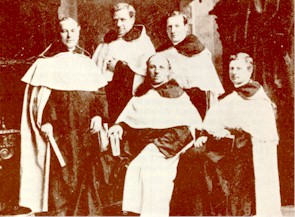 16 April 1881 – Irish Carmelites Joseph Butler, Ignatius Carr, Patrick Shaffrey, Brocard Leybourne and Hilarion Byrne (pictured right) arrive in Port Adelaide aboard the SS Liguria to begin the Australian Mission. It was Holy Saturday that year and the Prior of the Mission, Joseph Butler, continued on to Gawler the same day to celebrate his first Mass in Australia on Easter Sunday.
16 April 1881 – Irish Carmelites Joseph Butler, Ignatius Carr, Patrick Shaffrey, Brocard Leybourne and Hilarion Byrne (pictured right) arrive in Port Adelaide aboard the SS Liguria to begin the Australian Mission. It was Holy Saturday that year and the Prior of the Mission, Joseph Butler, continued on to Gawler the same day to celebrate his first Mass in Australia on Easter Sunday.
7 May 1882 – Carmelites celebrate their first Mass in St Joseph's Church, Port Melbourne, Fathers Butler and Shaffrey having accepted charge of the newly-formed parish of Sandridge.
October 1886 – Opening of Priory on Beaconsfield Parade.
January, 1902 – Carmelites move from Gawler to the parish of Port Adelaide. Carmelites withdrew from the Parish of Port Adelaide/Pennington on 10 January 1999.
1909 – Division of Sandridge parish into the parishes of Port Melbourne and Middle Park and establishment of separate priories.
28 June 1928 – Foundation of first Australian Novitiate at St Vincent’s Place, Albert Park, Vic. The Novitiate and House of Studies moved to Whitefriars, Kew in 1930 and then to Whitefrairs, Donvale in 1937. In 1946 the Novitiate was established in Wahroonga, NSW and moved from there to Hunters Hill in 1956 then to Lawson and in 1964 to Winston Hills. In 1974 the Novitiate returned to Donvale and moved to Vermont in 1976, returning to Donvale in 1977. In 1984 the Student House moved from Donvale to North Box Hill, returning to Donvale in 1986. The Novitiate and House of Studies were combined at Port Melbourne in 1987, returned to Whitefriars, Donvale in 1990, returning to Port Melbourne in 2000. In 2005 the Novitiate and House of Studies moved to Middle Park.
22 March 1930 – Foundation of the Australian Commissariat. Father Robert Power first Commissary General.
January, 1937 – Foundation at Cavendish Road, Coorparoo.
26 August 1937 – Opening of Whitefriars Monastery, Donvale, VIC by Archbishop D Mannix. Monastery was sold on 25 January 2002.
1947 – Foundation of the Lay Carmelites in Australia by Father E.J. Nugent.
13 September 1948 – Foundation of the Australian Province. Father E.J. Nugent first Provincial.
January, 1949 – Foundation at Meadowbank, New Zealand. Foundation closed in 1970.
1956 – Frs William Morganti and Robert Dowd together with Br George Parsons went to Southern Rhodesia (now Zimbabwe) to join the Carmelite mission which had been established by the Irish Province in 1946. The Province’s involvement continued until 1961.
1956 - Foundations at Hilton and Wentworthville. Foundation in Hilton closed on 31 January 2005.
1961 – Foundation of Whitefriars College at Donvale, VIC.
1973 - At the invitation of the Indonesian Province, the Australian Province took over the mission in Sumbul in North Sumatra in March 1973 and continued to have responsibility for it until 1982. In that year Fr Anthony Scerri, who had been parish priest in Sumbul, became vice rector of the new St Thomas’ University in Medan and remained there until September 1995 when he was elected General Councillor. The Australian mission in Indonesia ceased at that date.
27 January 1977 – Foundation of the House of Prayer at Vermont which moved in 1978 to Warburton, and of the Whitefriars College community firstly at East Doncaster, then at McGowans Road, Donvale in 1978 and finally at Merinda, Donvale in 1979.
8 May 2001 - Provincial Chapter: The Australian Carmelites accept the invitation of the Indonesian Carmelites to incorporate Timor-Leste (East Timor) as part of the Australian Province.
16 August 2001 – The Australian Carmelites accept responsibility for the Carmelite Presence in Timor-Leste and for the Mission Parish of Zumalai.
2 August 2004 - Foundation of the first Timor-Leste Novitiate at Fatuhada, Dili.
24 September 2004 - Change of Province name to ‘Australia and Timor-Leste’
22 January 2005 - Reunification of the parishes of St Joseph, Port Melbourne and Our Lady of Mount Carmel, Middle Park as one parish.
20 July 2005 - Foundation of Titus Brandsma Community, Fatuhada, Dili.
17 April 2007 - Foundation of St Elijah Novitiate in Hera, Timor-Leste.
29 July 2009 - Carmelite Centre formally launched by Fr Wayne Stanhope, Prior Provincial.
8 May 2010 - Blessing & opening of St Nuno Student House, Hera, Timor-Leste.
History of the Carmelite Order
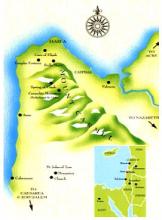 Origins & growth
Origins & growth
The Order of Carmelites has its origins on Mount Carmel, in Palestine, where, as we read in the first Book of Kings, the great prophet Elijah defended the true faith in the God of Israel, when he won the challenge against the priests of Baal. It was also on Mount Carmel that the same prophet, praying in solitude, saw the small cloud which brought life-giving rain after the long drought. From time immemorial, this mountain has been considered the lush garden of Palestine and symbol of fertility and beauty. Indeed, "Karmel" means "garden".
In the 12th century (perhaps after the third crusade, 1189-1191), some pilgrims who had come from Europe, came together near the "spring of Elijah", in one of the narrow valleys of Mount Carmel, to live out their Christianity as hermits after the example of the prophet Elijah in the very land of our Lord Jesus Christ. Then and in later times, the Carmelites did not acknowledge anyone in particular as their founder, but remained faithful followers of Elijah who was associated with Mount Carmel through biblical events and through Greek and Latin patristic tradition which saw in the prophet one of the founders of the monastic life. In the middle of the cells they built a chapel which they dedicated to Mary, Mother of Jesus, thus developing a sense of belonging to Our Lady as Patroness, and they became known by her name as "Brothers of Saint Mary of Mount Carmel". Thus Carmel is deeply associated with Elijah and Mary. From Elijah the Carmelites inherited a burning passion for the living and true God and the desire to make His Word intimately their own in order to witness to Its presence in the world; with Mary, the Mother of God, they are committed to live "in the footsteps of Jesus Christ" with the same intimate and deep feelings which were Mary's.
In order to have some juridical stability, this group of lay hermits turned to the Patriarch of Jerusalem, Albert Avogadro (1150-1214), who was then living at St John of Acre near Mount Carmel. Between 1206-1214, Albert wrote for them a formula of life. Successive approvals of this formula of life by various Popes helped the process of transforming the group into a Religious Order, a fact which took place at the time of the definitive approval of the text as a Rule by Innocent IV in 1247. Thus the Carmelite Order took its place alongside the Mendicant Orders.
However, about 1235, the Carmelites were forced to abandon their place of origin due to the incursions and persecutions of the Saracens who were reconquering the Holy Land from the crusaders. Most of them went back to their country of origin in Europe.
Soon they increased and flourished in the sciences and in holiness. Later some women attached themselves to the monasteries of the friars and in 1452 became cloistered nuns living in their own communities.
Reform & development
In the 15-16th centuries there was some relaxation of discipline in various communities, a fact greatly opposed by Priors General such as Blessed John Soreth (+1471), Nicholas Audet (+1562) and John Baptist Rossi (+1578), and by some reforms (among others those of Mantua and Monte Oliveti in Italy and of Albi in France) to put a stop to the spread of the abuses and the mitigations. The most famous reform is certainly the one started in Spain by St Teresa of Jesus for the reform of the nuns and then, helped by St John of the Cross and Fr Girolamo Gracian, for the reform of the friars. The most relevant aspect of this reform of Teresa is not so much that she opposed the mitigations introduced in the life of Carmel, but rather her ability to integrate in her project, vital and ecclesial elements of her time. In 1592 this reform, called that of the "Discalced Carmelites" or of the "Teresians", became independent from the Carmelite Order and grew rapidly in the congregations of Spain and Italy which were then united in 1875. Thus there are two Orders of Carmelites: "The Carmelites", also known as of the "Ancient Observance" or "Calced", and "The Discalced Carmelites" or "Teresians" who consider St Teresa of Jesus their reformer and foundress.
In spite of this division, during the following centuries the Carmelite Order continued its spiritual journey. Many illustrious men and women gave new spirit to Carmel with their own spirituality and genius. There was also significant development among the laity with the institution of the Carmelite Third Order and the Confraternities of the Scapular of Our Lady of Mt Carmel throughout the world. With the Reforms of Touraine in France, and of Monte Santo, Santa Maria della Vita, Piedmont, and Santa Maria della Scala in Italy, in the XVII and XVIII centuries the movement for a stricter observance spread everywhere.
At the dawn of the French Revolution, the Carmelite Order was established throughout the world with 54 Provinces and 13,000 religious. But as a result of the French Revolution the Order suffered great losses, such that at the end of the 19th century it was reduced to 8 Provinces and 727 religious. But it was this small band of religious who during the 20th century, with determination and courage, re-established the Order in places where it had been and also planted the Order on new continents.
The Carmelite Order today
Since the time of the Second Vatican Council (1962 - 1965), Carmelites have reflected at length on their identity, on their charism, on what is fundamental in their lives and what is for them a "life-project", namely "to live a life of allegiance to Jesus Christ and serve him faithfully with a pure heart and a good conscience" (Rule). They found their allegiance to Christ in their commitment to seek the face of the living God (contemplative dimension), in living in fraternity and service (diakonia) in the midst of the people. They see all this in the lives of the prophet Elijah and the Blessed Virgin Mary who were led by the Spirit of God. Looking at Mary and Elijah, it is easy for the Carmelites to understand, to interiorise, to live and to announce the truth that makes a person free.
Carmelites, conscious of being part of the Church and of history, live in a fraternity that is open to God and to people, able to listen and give an authentic response to the evangelical life according to their own charism, and they commit themselves to build the Kingdom of God wherever they are. Indeed they are committed to evangelisation in houses of prayer, centres for spiritual exercises, parishes, Marian sanctuaries, schools, religious associations; and to Justice and Peace wherever human dignity is trodden underfoot, especially among the poor, the marginalised, the suffering.
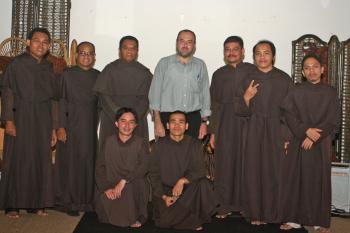 To this vast and varied challenge of the Carmelite friars, one will find in close collaboration: communities of cloistered nuns, Congregations of sisters, Consecrated Lay people, numerous groups of Third Order Lay members and Confraternities of the Scapular of Our Lady of Mt. Carmel. All these groups, born of the Spirit throughout the centuries, and inspired by the Carmelite Rule are intimately united by the bond of love, of spirituality and of the communion of spiritual goods. They constitute the Carmelite Family in the Church. At present the Carmelite Order (the friars) is formed of Provinces, General Commissariats, General Delegations, Hermetical Communities and an Affiliated Community with a total of about 2,000 religious. They are found in all the continents.
To this vast and varied challenge of the Carmelite friars, one will find in close collaboration: communities of cloistered nuns, Congregations of sisters, Consecrated Lay people, numerous groups of Third Order Lay members and Confraternities of the Scapular of Our Lady of Mt. Carmel. All these groups, born of the Spirit throughout the centuries, and inspired by the Carmelite Rule are intimately united by the bond of love, of spirituality and of the communion of spiritual goods. They constitute the Carmelite Family in the Church. At present the Carmelite Order (the friars) is formed of Provinces, General Commissariats, General Delegations, Hermetical Communities and an Affiliated Community with a total of about 2,000 religious. They are found in all the continents.
About the Lay Carmelites
Since our beginnings in the 13th century, Carmelites have sought to follow Christ in a fraternal community united in a spirit of contemplative prayer and our desire to be of service to God and to the people among whom we live. The Lay Carmelites are just what the name implies: lay men and women who form an integral part of the Carmelite family and try to live out the Carmelite way of life in the ordinary circumstances of our family and social life.
Carmelite Charism
A charism is a gift from God to the Church for the world. With regard to a Religious Order, the term refers to the gift which God gives to an individual or group to inspire the founding of a new religious family within the Church. This gift is handed down through the centuries and enriched by all who are called to live it. The charism of each religious family is the particular way in which its members are called to follow Christ. Since all Christians follow Christ, the charisms will have many elements in common, but the way in which these elements are emphasised gives each religious group its unique feel. All religious families have been asked by the Church to rediscover their original founding charism and make it come alive in each culture and in every age.
The charism of the Carmelite Order is God's gift given originally to those nameless hermits who gathered together on Mount Carmel, beside the well of Elijah, at the end of the 12th and beginning of the 13th centuries. The Carmelite Order has no known founder but sprang from the desire of those first hermits to follow Christ together with a pure heart and a good conscience. They asked the Patriarch of Jerusalem, St Albert, to write for them a rule of life (c.1206-1214) which laid down certain guidelines based on the previous way of life of the hermits.
This Rule of St Albert and the experience of the Carmelites as they sought to be faithful to it in various circumstances gave definitive shape to the charism. We can say that there are several elements which make up the Carmelite charism. Firstly, and most importantly, it is a way of following Christ with total dedication. Carmelites do this by seeking to form contemplative communities at the service of God's people in whose midst they live. Fraternity, service and contemplation are therefore essential values for all Carmelites.
Fraternity
Carmelites seek to form communities where each person feels accepted and valued not for what he can do but simply because he is. This kind of community is in itself a witness that the love of Christ can break down the barriers which human beings set up and that it is possible for people of different backgrounds and nationalities to live together in peace and harmony. Carmelites are also aware of being part of an international fraternity which is present in many parts of the world.
Service
The hermits were forced to leave their home on Mount Carmel and settle in Europe. There they changed their style of life from hermits to friars. The major difference is that friars are called to serve the People of God in some active apostolate. Some Religious Congregations were founded for a specific work but the Carmelite Order tries simply to respond to the needs of the Church and the world which differ according to time and place, and so, many friars work in parishes, schools, universities, retreat centres, prisons, hospitals etc. The kind of service which each individual friar is involved in will depend on the needs of the people in whose midst he lives and his own particular talents.
Contemplation
The heart of the Carmelite charism is prayer and contemplation. The quality of our prayer determines the quality of the community life and the quality of the service which is offered to others. The goal of the Carmelite life is union with God. We seek to live in God's presence and consent to God's will for us. This involves us in listening to God who speaks to us in many ways and especially in the words of Scripture. Prayer is the way we relate to God and as we grow in friendship with Christ our prayer will tend to become more and more simple. The relationship with Christ will change us, impelling us to move out of the prison of selfishness towards the bright daylight of pure love for God and our fellow men and women. We are called to embark on a journey of faith whereby we are gradually stripped of all that is not God so that we can put on Christ. We do all we can to respond to God's initiative in calling us but we are very aware that in the end only God can change our hearts and so we learn to wait patiently for the coming of God to us. As we follow Christ along this path of trust in God we are inspired by the example and virtues of Mary, the mother of Jesus, and the Prophet Elijah.
Prayer and contemplation for the Carmelite are not private matters between the individual and God but are to be shared with others since the charism is given for the whole world. Therefore there is an emphasis in the Order on the ministry of teaching prayer and giving spiritual direction. The Carmelite is aware that the transformation of the human heart by God may be hidden from most eyes but has far reaching consequences for our world. The way of prayer is mysterious and goes beyond our normal human categories. Prayer opens us to the Ultimate Mystery.
The Brown Scapular
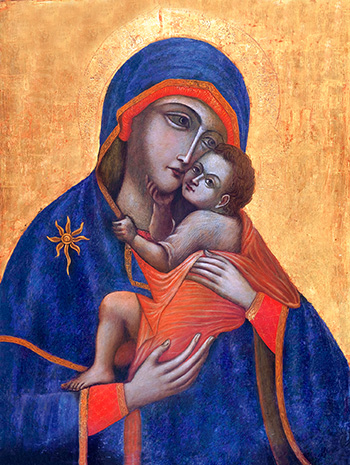 Signs in ordinary human life
Signs in ordinary human life
The world in which we live is full of material things which have symbolic meaning: light, fire, water...
There are also, in everyday life, experiences of relationships between human beings, which express and symbolise deeper realities such as sharing a meal (as a sign of friendship), taking part in a protest march (as a sign of solidarity), joining together in a national celebration (as a sign of identity).
We need signs and symbols to help us understand what is happening at present, or what happened before, and to give us an awareness of who we are, as individuals and as groups.
Signs in Christian life
Jesus is the great sign and gift of the Father’s love. He founded the Church as a sign and instrument of his love. Christian life also has its signs. Jesus used bread, wine, and water, to help us understand higher things, which we can neither see nor touch.
In the celebration of the Eucharist and the other sacraments (Baptism, Confirmation, Reconciliation, Matrimony, Holy Orders, the Sacrament of the Sick) the symbols, (water, oil, the laying on of hands, the rings), all have their own meaning and bring us into communication with God, present in each of them.
As well as liturgical signs, the Church has others related to some event, to some tradition, or some person. One of these is the Brown Scapular of Our Lady of Mount Carmel.
The Scapular is a sign of Mary
One of the signs in the tradition of the Church from many centuries ago is the Brown Scapular of Our Lady of Mount Carmel. It is a sign approved by the Church and accepted by the Carmelite Order as an external sign of love for Mary, of the trust her children have in her, and of commitment to live like her.
The word scapular indicates a form of clothing which monks wore when they were working.
With the passage of time, people began to give symbolic meaning to it: the cross to be borne every day as disciples and followers of Christ. In some religious orders, such as the Carmelites, the Scapular turned into a sign of their way of life. The Scapular came to symbolise the special dedication of Carmelites to Mary, the Mother of God, and to express trust in her motherly protection as well as desire to be like her in her commitment to Christ and to others. Thus it became a sign of Mary.
From Religious Orders to the People of God
In the middle ages many Christians wanted to be associated with the Orders founded at that time: Franciscans, Dominicans, Augustinians and Carmelites. Groups of lay people began to emerge in associations such as confraternities and sodalities.
All the religious Orders wanted to give these lay people a sign of affiliation and of participation in their spirit and apostolate. That sign was often a part of their habit: a cloak, a cord, a scapular.
Among the Carmelites, the stage came when a smaller version of the Scapular was accepted as the sign of belonging to the Order and an expression of its spirituality.
The value and meaning of the Scapular
The Scapular finds its roots in the tradition of the Order, which has seen in it a sign of Mary’s motherly protection. It has, therefore, a centuries old spiritual meaning approved by the Church:
It stands for a commitment to follow Jesus, as did Mary, the perfect model of all the disciples of Christ. This commitment finds its origin in baptism by which we become children of God.
The Blessed Virgin teaches us,
- to be open to God, and to his will shown to us in the people, circumstances and events of our lives;
- to listen to the Word of God in the bible and in life, to believe in it and to put into practice its demands;
- to pray always,as a way of discovering the presence of God in all that is happening around us;
- to be involved with people, being attentive to their needs.
It leads us into the community of Carmel, a community of religious and lay men and women, which has existed in the Church for eight centuries. It calls on us to live out the ideal of the Carmelite family: intimate friendship with God in prayer.
It reminds us of the example of the saints of Carmel, with whom we establish a close bond as brothers and sisters to one another.
It is an expression of our belief that we will meet God in eternal life, aided by the intercession and prayer of Mary.
Some practical rules
People are enrolled in the Scapular only once, by a priest or authorised person.
The Scapular can be replaced afterwards by a medal which has on one side the image of the Sacred Heart of Jesus and on the other the image of Mary.
The Scapular holds us to live as authentic Christians in line with the teaching of the Gospel, to receive the sacraments, to profess our special friendship for Mary, which should be expressed each day – for example, by praying the Hail Mary, prayerful reading of the Scriptures, service to someone in need.
The Carmelite Scapular
is not:
- a magical charm to protect you
- an automatic guarantee of salvation
- an excuse for not living up to the demands of Christian life;
it is:
A Sign which
stands for the decision to follow Jesus as Mary did:
- open to God and to God's will,
- guided by faith, hope and love,
- close to the needs of people,
- praying always,
- discovering God present in our life;
brings people into the family of Carmel;
with Mary's help, strengthens our desire to be with God forever.














